Why Inlays?
In a piece with large flat surfaces, like a table or a medium size credenza, the large panels with uniform grain, or with symmetrical matched grain, often provide for a heavy appearance. Inlays were created for such purpose: to break the monotony and to help to light up the piece. This is true even if we know that inlay has developed well beyond such simple tasks, becoming an art of its own.patterns are
of most
general use
use of spices
and tapes
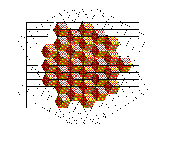
3-Dimensional Cubes
Let's take the well known pattern of 3-Dimensional cubes and let's develop it. It's a pattern in use, with varying popularity, since centuries. It can be easily obtained with marquetry with angles of 60°/120°. These can be cut from strips of veneer with parallel cuts having a slope of 60°. The pattern that you obtain is as in figure, completed with the details of the geometrical construction. The various marquetry than are matched to obtain the simple, repetitive, pattern as many times as needed to cover your intended surface. They are kept in place with paper tape. The best tape for this use is the special one with holes, that limits the degree of adhesion of the glue. This is an important detail. After gluing the veneer and the glue is cured, the removal of the tape has to be done with care. Some glues used for the tapes, although they may feel to hardly provide a strong bond when you touch the tape, are often more than enough to drag with them some fibers of the veneer. This happens in particular when the gluing is done applying pressure to the piece (like with ordinary vinylic glues). The tapes with holes reduce this side effect. Or your patience, with the help of a craft knife to check splitting fibers, will do the same.to chose
may also be
simply used
as matching
pattern
Automatic calculation
with JavaScript!
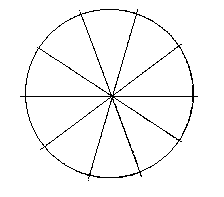 The Sun Burst
The Sun Burst
Another example of a simple geometric design is the so called sun burst, i.e. a circle of identical sections. This pattern can be used not only as an inlay, but also as a common way to cover circular surfaces with veneer. But it is obviously possible to alternate sections of two different spices in order to obtain an ornamental effect. The only necessary care is that, normally, an even number of sections is used, for aesthetic reasons as well as for simplicity of assembly (using an even number of sections first you assemble to identical halves, and than you assemble the two together). In the picture proposed, 10 sections of 36° are used. The calculation of the width of the section is carried out with a little of trigonometry. The trigonometry becomes slightly more complex if you want to compute the number of sections needed of a given maximum width. This last one is the most common actual case, since normally you'll try to use the available sheets of veneer at their best, either for quantity than for grain.
Automatic Calculation
with JavaScript!
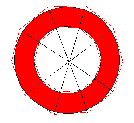 A simple modification to the sun burst is its corona. This pattern is ideal to inlay a circular surface with concentric designs (it's a common one on round tables), or to provide an adequate frame to other designs. Obviously this is also the case to determine the number of sections to be used as for the sun burst. Here the computation becomes a little more complex. I provide the formulas to compute the section size for a circular corona of a given number of sections, and the number of sections of a circular corona having available veneer sheets of given dimensions.
A simple modification to the sun burst is its corona. This pattern is ideal to inlay a circular surface with concentric designs (it's a common one on round tables), or to provide an adequate frame to other designs. Obviously this is also the case to determine the number of sections to be used as for the sun burst. Here the computation becomes a little more complex. I provide the formulas to compute the section size for a circular corona of a given number of sections, and the number of sections of a circular corona having available veneer sheets of given dimensions.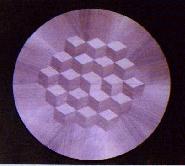 |
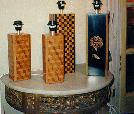 |
 |
A good source for further reading on the topic of inlays is the site of the Marquetry Society Of Canada, with a vast collection of articles from their News Letter.